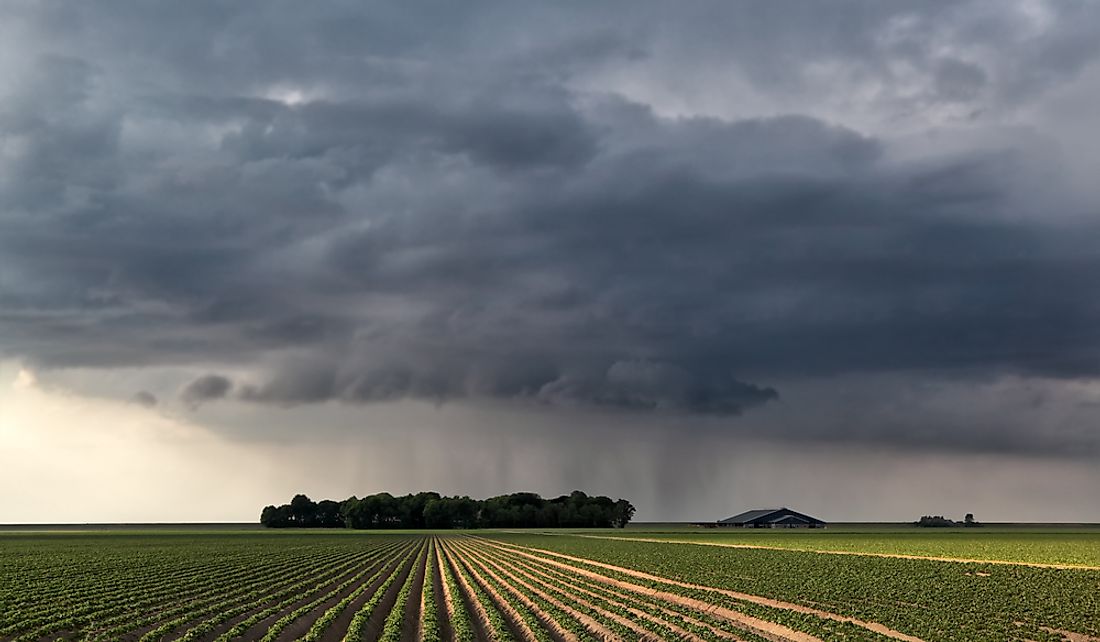What Kind Of Climate Does The Netherlands Have?

The Netherlands is a country located in northwestern Europe. The name Netherlands means a low lying country. The North Sea is found to the west and north of the country, Belgium is found to the south, and Germany to the east. The country is generally low-lying and flat with vast expanses of rivers, lakes, and canals. An estimated 2,500 square miles of the nation's territory is comprised of reclaimed land. Land reclamation in the country's interior involves draining lakes and marshes, and along the coastland, the land is also reclaimed from the sea. Reclaimed land is typically turned into polders and surrounded by dikes. The nation's climate is classified as CFD according to the Koeppen-Geiger classification. The classification has warm temperate, humid climate with the warmest months experiencing temperatures below 71.6 degrees Fahrenheit and four or more months with average temperatures over 50 degrees Fahrenheit.
Climate
The nation's climate is temperate with cool summers, gentle winters, and rainfall in all seasons. The climate is influenced by both the Atlantic Ocean and the North Sea. The temperate climate offers distinct winter and summer seasons. The influence of the North Sea and the Atlantic Ocean results in winters which are typically not too cold and summers that are not usually too hot. It also results in a lot of showers and plenty of moisture in the air. Southerly and Westerly winds occur, and the sea moderates the climate with onshore winds and the Gulf-Stream effect. The location of the country is between a low-pressure region with its center in Iceland and an area of high-pressure air masses with their center in the Azores. The collision of the air masses results typically in the unsettled weather in the country.
The climate in the country is mainly uniform due to the country’s small size and flat relief. The country also experiences greater continentality in the country's inland compared to coastal areas, which are windier. Wind experiences little resistance due to the flat nature of a significant part of the nation's landscape. Considerable resistance is experienced due to the hills to the south of the country which significantly lowers the velocity of winds prevalent along the coast.
Frost is experienced for an average of 60 days while there is an average of 25 days of clear weather a year. The average day has a sky that is three-fifths clouded. The prevalent cloud cover translates to a relatively low average number of hours of sunshine experienced. The sunniest months are in May and June. Summers in the Netherlands are generally warm with changeable weather periods. Winters are relatively cold and experience occasional snow. Thick fog is also common during the winter.
Winds
The country's location often means that it experiences strong gales, winds, and uncomfortable weather due to strong Atlantic low-pressure systems, especially in the winter and autumn months. Easterly winds bring continental weather making the nation warm during summer and cold during the winter with temperatures at times dropping to sub-zero temperatures.
Weather
The nation's weather is to a great extent unpredictable. The summer could have a month that is hot and sunny while the following month could be cool and rainy. It is therefore common to find the Dutch population which is normally cheerful occasionally complaining about the weather. The weather's unpredictability is attributed to its lack of mountains, seaside location, as well as the fact that the country is found on the border between cold and hot weather regions. Depressions that blow in from the sea experience low resistance are therefore not stopped. The nations unpredictable weather can at times make it seem as if it is always raining.
Temperatures
The nation’s average temperatures are about 50 degrees Fahrenheit. Average daytime temperatures during the winter vary between 35.6 to 42.8 degrees Fahrenheit while average daytime temperatures during the summer vary between 62.6 and 68 degrees Fahrenheit. Temperatures in January average around 35 degrees Fahrenheit while temperatures in July average at about 63 degrees Fahrenheit. The highest temperature recorded was in 1944 with temperatures peaking at 101.3 degrees Fahrenheit. The lowest temperature recorded also occurred in the same year which hit -17.32 degrees Fahrenheit.
Rainfall
Rainfall in the country is fairly stable during the year. The driest periods are experienced between April and September. The country experiences average rainfall of 31 inches with the highest rainfall experienced in the summer during August. High rainfall is also experienced in the autumn. The least amount of rainfall is experienced during springtime. The nation has an average of 25 dry days in a year. March is by far the driest month in the year.
Adaptation to the Country's Climate
The nation's mild, damp climate makes it ideal for dairy farming. The limited hours of sunshine, however, limit the growth of crops. The country is quite windy due to its flat landscape which makes it perfect for wind farms. The possibility of extreme weather is low. The possibility of floods and sea storms is however relatively high. The nation experienced devastating floods in 1287, 1421 and 1953 which resulted in the loss of lives. Measures have since been taken to mitigate the events and protect the land as well as the residents from flooding. Some of the measures include the construction of a dike system and pumping stations located throughout the nation.











